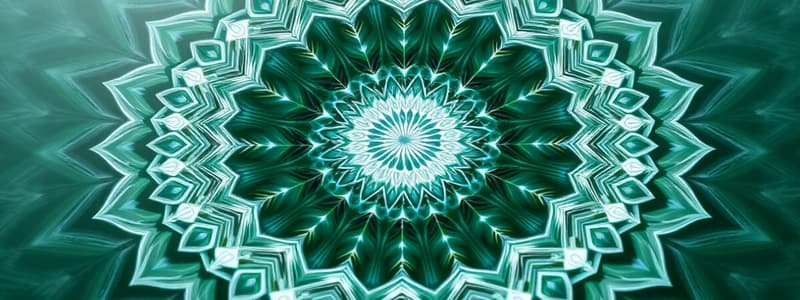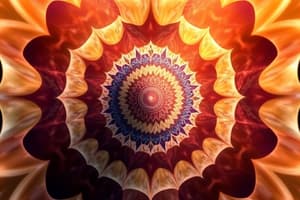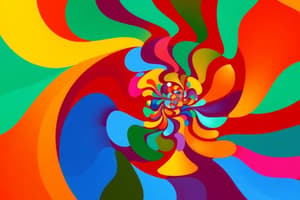Podcast
Questions and Answers
What does the study of mathematics primarily involve?
What does the study of mathematics primarily involve?
- Relationships among people and society
- Relationships among colors and shapes
- Relationships among letters and words
- Relationships among numbers, quantities, and shapes (correct)
Which type of symmetry allows for an imaginary line to divide an object into mirror image halves?
Which type of symmetry allows for an imaginary line to divide an object into mirror image halves?
- Translational Symmetry
- Line or Bilateral Symmetry (correct)
- Radial Symmetry
- Rotational Symmetry
Which of the following best describes a spiral in mathematics?
Which of the following best describes a spiral in mathematics?
- A curve moving closer to a point
- A closed shape with all sides equal
- A curve that moves farther away from a point while revolving around it (correct)
- A straight line extending infinitely
What is a pattern in nature typically characterized as?
What is a pattern in nature typically characterized as?
What does the concept of symmetry in mathematics help identify?
What does the concept of symmetry in mathematics help identify?
Which mathematical concept involves disturbances propagating through one or more quantities?
Which mathematical concept involves disturbances propagating through one or more quantities?
What is the main purpose of mathematics as described?
What is the main purpose of mathematics as described?
Which of the following symmetries involves rotation around a central point?
Which of the following symmetries involves rotation around a central point?
What is the defining feature of tessellation in geometry?
What is the defining feature of tessellation in geometry?
Which philosopher is NOT mentioned as studying patterns in nature?
Which philosopher is NOT mentioned as studying patterns in nature?
What major contribution did D'Arcy Thompson make to the study of patterns?
What major contribution did D'Arcy Thompson make to the study of patterns?
Which scientist is associated with soap films and the concept of minimal surfaces?
Which scientist is associated with soap films and the concept of minimal surfaces?
What does the Fibonacci sequence start with?
What does the Fibonacci sequence start with?
Who predicted mechanisms of morphogenesis leading to patterns of spots and stripes?
Who predicted mechanisms of morphogenesis leading to patterns of spots and stripes?
Which statement best describes the Fibonacci sequence's relation to nature?
Which statement best describes the Fibonacci sequence's relation to nature?
What area of study did Aristid Lindenmayer and Benoit Mandelbrot focus on?
What area of study did Aristid Lindenmayer and Benoit Mandelbrot focus on?
What is the starting point of the Fibonacci sequence?
What is the starting point of the Fibonacci sequence?
How is each term in the Fibonacci sequence generated?
How is each term in the Fibonacci sequence generated?
What does the ratio of successive Fibonacci numbers approach?
What does the ratio of successive Fibonacci numbers approach?
Who is the Fibonacci sequence named after?
Who is the Fibonacci sequence named after?
Which of the following sequences is incorrect within the context of Fibonacci numbers?
Which of the following sequences is incorrect within the context of Fibonacci numbers?
What is Binet’s Formula used for in relation to Fibonacci numbers?
What is Binet’s Formula used for in relation to Fibonacci numbers?
Which of the following values is an approximation of the Golden Ratio (Φ)?
Which of the following values is an approximation of the Golden Ratio (Φ)?
What type of mathematical concept does the Fibonacci sequence represent?
What type of mathematical concept does the Fibonacci sequence represent?
What defines a mixed sequence?
What defines a mixed sequence?
Which of the following is an example of a square number sequence?
Which of the following is an example of a square number sequence?
What characterizes an arithmetic sequence?
What characterizes an arithmetic sequence?
In the sequence 12, 20, n, 36, 44, what is the value of n?
In the sequence 12, 20, n, 36, 44, what is the value of n?
Identify the next term in the sequence 0, 10, 30, 70, 150.
Identify the next term in the sequence 0, 10, 30, 70, 150.
Which type of sequence is formed by taking the reciprocals of an arithmetic sequence?
Which type of sequence is formed by taking the reciprocals of an arithmetic sequence?
What is the next number in this sequence: 5, 3, 1, −1, −3?
What is the next number in this sequence: 5, 3, 1, −1, −3?
What is true about a geometric sequence?
What is true about a geometric sequence?
What defines a quadratic sequence?
What defines a quadratic sequence?
Which of the following sequences involves consistent addition or subtraction?
Which of the following sequences involves consistent addition or subtraction?
Which of the following sequences does NOT have a common ratio between its terms?
Which of the following sequences does NOT have a common ratio between its terms?
In which kind of sequence is the second difference between terms constant?
In which kind of sequence is the second difference between terms constant?
Which of the following options best represents a utility of mathematics in the context provided?
Which of the following options best represents a utility of mathematics in the context provided?
Flashcards are hidden until you start studying
Study Notes
### Mathematics
- The study of relationships among numbers, quantities, and shapes.
- Includes arithmetic, algebra, trigonometry, geometry, statistics, and calculus.
- Helps organize patterns and regularities in the world.
- The science of patterns.
Patterns in Nature
- Regular, repeated, or recurring forms or designs.
- Examples include symmetries, spirals, waves, foams, and tesselations.
Symmetry
- Imaginary line across an object where resulting parts are mirror images.
- Types: Line or Bilateral symmetry, Rotational symmetry.
Fibonacci Sequence
- Each number is the sum of the two preceding ones.
- Starts with 0 and 1.
- Ratios of successive Fibonacci numbers approach the Golden Ratio (Φ), approximately equal to 1.618.
- Found in nature and considered aesthetically pleasing in art and architecture.
### Mathematics for Our World
- Helps organize patterns and regularities.
- Helps predict the behavior of nature and phenomena.
- Helps exert control over occurrences in the world to advance civilization.
Sequences
- Ordered list of numbers called terms.
- Arrangement set by a definite rule.
Types of Sequences
- Arithmetic Sequence: Common difference between each term.
- Geometric Sequence: Common ratio between each term.
- Quadratic Sequence: Constant second difference between consecutive terms.
- Harmonic Sequence: Constant difference between the reciprocals of consecutive terms.
- Mixed Sequence: More than one arithmetic operation in the rule.
- Square Number Sequence: Squares of integers.
- Cube Number Sequence: Cube of integers.
Studying That Suits You
Use AI to generate personalized quizzes and flashcards to suit your learning preferences.




